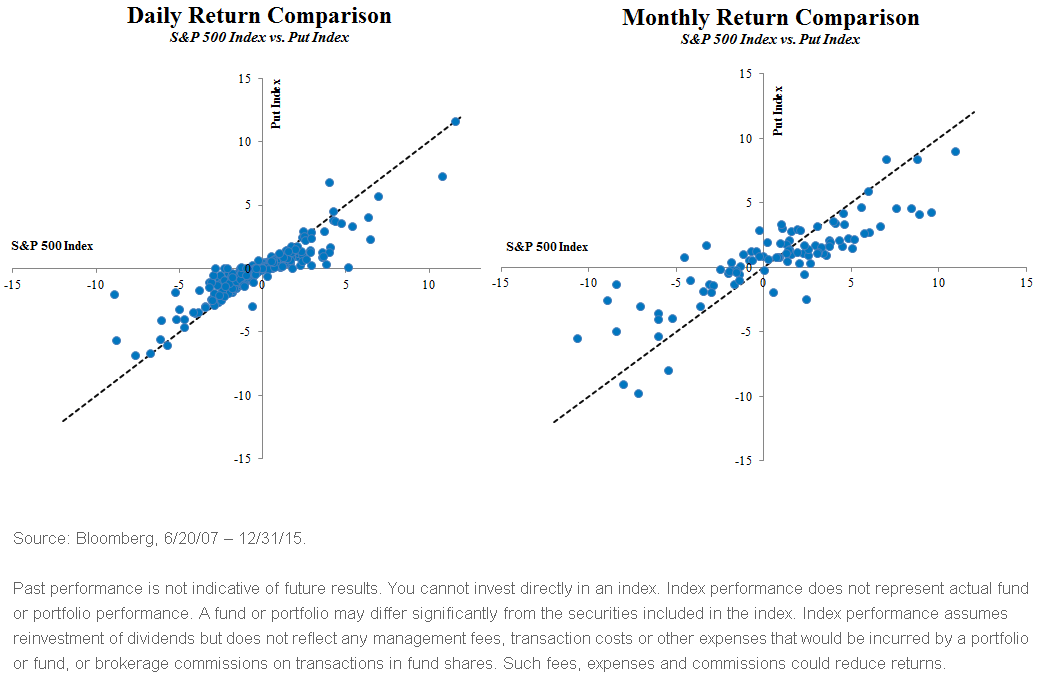PutWrite Strategy Fund: A Risk Mitigating Allocation to Investors’ Portfolios



 For definitions of terms in the charts, visit our glossary.
The charts above are scatter plots with returns of PUT (on the vertical axis) and returns of the S&P 500 Index (on the horizontal axis) since the live inception of PUT.
The chart on the left is with daily returns, and the chart on the right is the same, just plotted with monthly returns. If the returns of the two indexes (i.e., PUT and S&P 500) were the exact same, all dots would lie on the 45-degree line. When a dot is above this line, PUT had better returns than SPX on that day; if a dot is below the 45-degree line, then the reverse is true (SPX outperformed PUT on that day).
Downside Cushions: Most of the dots on the lower-west quadrant or negative side of the horizontal axis (i.e., when the S&P 500 had negative returns) lie above the line. This means on days when the S&P 500 experienced negative returns, PUT fared better. Intuitively, this occurred because put writers collected premiums upfront from the selling of puts, which acted as cushion for the drawdowns.
A more detailed look reveals that average returns of the S&P 500 Index when it was negative were -0.95% for daily returns (and -3.65% for monthly), compared to -0.65% for daily returns of PUT (and -2.64% for monthly). This means:
• For days when the S&P 500 experienced negative returns, average PUT returns were 30 basis points (bps) higher than average returns for the S&P 500.
• Similarly, on a monthly basis (right chart), when S&P 500 returns were negative, average returns of PUT were 101 bps higher than average returns for the S&P 500.
• PUT not only performed better, it did so with lower volatility (as measured by standard deviation) during times of S&P 500 corrections.
In fairness, upside (i.e., upper or east quadrant) returns PUT generated mostly lagged. While SPX had average upside returns of 85 bps, PUT went up by 39 bps only. However, here too 39 bps was realized with significantly lower volatility (which would make PUT attractive from a risk-adjusted basis even on the upside).
In simple words, what it boils down to is this: During times of market correction, PUT not only performed better than the S&P 500 Index, but it did so with lower volatility, making it attractive from a risk-adjusted basis.
Thus, individual days may differ, and it certainly is possible that PUT performed worse than the S&P 500 on any single down day; historically it has happened only a few times. Thus, quite contrary to the perception of PUTW being more risky, it could actually act as a risk-mitigating complement. We believe by incorporating an allocation to PUTW, investors could provide a necessary cushion to portfolio returns during market corrections and could help improve the overall risk-adjusted performance of their portfolios.
Unless otherwise noted, data source is Bloomberg, as of 12/31/15.
For definitions of terms in the charts, visit our glossary.
The charts above are scatter plots with returns of PUT (on the vertical axis) and returns of the S&P 500 Index (on the horizontal axis) since the live inception of PUT.
The chart on the left is with daily returns, and the chart on the right is the same, just plotted with monthly returns. If the returns of the two indexes (i.e., PUT and S&P 500) were the exact same, all dots would lie on the 45-degree line. When a dot is above this line, PUT had better returns than SPX on that day; if a dot is below the 45-degree line, then the reverse is true (SPX outperformed PUT on that day).
Downside Cushions: Most of the dots on the lower-west quadrant or negative side of the horizontal axis (i.e., when the S&P 500 had negative returns) lie above the line. This means on days when the S&P 500 experienced negative returns, PUT fared better. Intuitively, this occurred because put writers collected premiums upfront from the selling of puts, which acted as cushion for the drawdowns.
A more detailed look reveals that average returns of the S&P 500 Index when it was negative were -0.95% for daily returns (and -3.65% for monthly), compared to -0.65% for daily returns of PUT (and -2.64% for monthly). This means:
• For days when the S&P 500 experienced negative returns, average PUT returns were 30 basis points (bps) higher than average returns for the S&P 500.
• Similarly, on a monthly basis (right chart), when S&P 500 returns were negative, average returns of PUT were 101 bps higher than average returns for the S&P 500.
• PUT not only performed better, it did so with lower volatility (as measured by standard deviation) during times of S&P 500 corrections.
In fairness, upside (i.e., upper or east quadrant) returns PUT generated mostly lagged. While SPX had average upside returns of 85 bps, PUT went up by 39 bps only. However, here too 39 bps was realized with significantly lower volatility (which would make PUT attractive from a risk-adjusted basis even on the upside).
In simple words, what it boils down to is this: During times of market correction, PUT not only performed better than the S&P 500 Index, but it did so with lower volatility, making it attractive from a risk-adjusted basis.
Thus, individual days may differ, and it certainly is possible that PUT performed worse than the S&P 500 on any single down day; historically it has happened only a few times. Thus, quite contrary to the perception of PUTW being more risky, it could actually act as a risk-mitigating complement. We believe by incorporating an allocation to PUTW, investors could provide a necessary cushion to portfolio returns during market corrections and could help improve the overall risk-adjusted performance of their portfolios.
Unless otherwise noted, data source is Bloomberg, as of 12/31/15.
Important Risks Related to this Article
There are risks associated with investing, including possible loss of principal. The Fund will invest in derivatives, including S&P 500 Index put options (“SPX puts”). Derivative investments can be volatile, and these investments may be less liquid than other securities, and more sensitive to the effects of varied economic conditions. The value of the SPX puts in which the Fund invests is partly based on the volatility used by market participants to price such options (i.e., implied volatility). Increases in the implied volatility of such options will cause their value to increase, which will result in a corresponding increase in the liabilities of the Fund and a decrease in the Fund’s NAV. Options may be subject to volatile swings in price influenced by changes in the value of the underlying instrument. The potential return of the Fund is limited to the number of option premiums it receives; however, the Fund can potentially lose up to the entire strike price of each option it sells. Due to the investment strategy of the Fund, it may make higher capital gain distributions than other ETFs. Please read the Fund’s prospectus for specific details regarding the Fund’s risk profile.
WisdomTree Funds are distributed by Foreside Fund Services, LLC. in the U.S. only. Foreside Fund Services, LLC, is not affiliated with CBOE and S&P.
The CBOE S&P 500 PutWrite Index is a product of S&P Dow Jones Indices LLC or its affiliates (“SPDJI”) and CBOE, and has been licensed for use by WisdomTree. Standard & Poor’s® and S&P® are registered trademarks of Standard & Poor’s Financial Services LLC (“S&P”); Dow Jones® is a registered trademark of Dow Jones Trademarks Holdings LLC (“Dow Jones”). These trademarks have been licensed for use by SPDJI and sublicensed for certain purposes by WisdomTree. CBOE® is a trademark of the Chicago Board Options Exchange, Incorporated, and has been licensed for use by SPDJI and WisdomTree. The WisdomTree CBOE S&P 500 PutWrite Strategy Fund is not sponsored, endorsed, sold or promoted by SPDJI, Dow Jones, S&P, their respective affiliates or the Chicago Board Options Exchange, Incorporated, and none of such parties make any representation regarding the advisability of investing in such product(s), nor do they have any liability for any errors, omissions or interruptions of the CBOE S&P 500 PutWrite Index.


